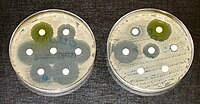
Photo from wikipedia
BackgroundShigella species are a major cause of dysentery and may attribute for death worldwide. Currently antibiotic resistance became the critical challenges for management of infectious disease. The aim was to… Click to show full abstract
BackgroundShigella species are a major cause of dysentery and may attribute for death worldwide. Currently antibiotic resistance became the critical challenges for management of infectious disease. The aim was to conduct a systematic review and meta-analysis of Shigella species and its drug resistance pattern in Ethiopia.MethodsA comprehensive literature search was conducted through internet searches using database of MEDLINE, PubMed, Google scholar, EMBASE, HINARI, Cochrane Library and reference lists of previous prevalence studies from January 1999 to November 2018. Results were presented in forest plot, tables and figures with 95% CI. The Cochrane Q test and I2 test statistic were used to test heterogeneity across studies. The Pooled estimate of Shigella species and its drug resistance pattern was computed by a random effects model.ResultsThe pooled prevalence of Shigella species in Ethiopia was 6.6% (95% CI 4.7–8.8). In the subgroup analysis, the highest prevalence was observed among patients in Health facility (8.5%, 95% CI 6.2–11.5) whereas the lowest prevalence was observed in Community based studies (1.6%, 95% CI 0.8–3.4). In addition, Shigella species were highly resistant to ampicillin, amoxicillin, erythromycin and multi-drug resistant (MDR) with the pooled resistance proportions of 83.1% (95% CI 75.7–88.6), 84.1% (95% CI 75.6–90.1), 86.5% (95% CI 70.9–94.4) and 83.2% (95% CI 77.1–87.9), respectively. On the other hand, comparably low resistance pattern was reported for ciprofloxacin 8.9% (95% CI 6.0–12.8), ceftriaxone 9.3% (95% CI 3.9–20.5), and norfloxacin 8.2% (95% CI 3.8–16.6) and gentamycin 17.3% (95% CI 11.2–25.9). Subgroup analyses indicated that study years were associated with a decreasing Shigella prevalence over time (p = 0.002).ConclusionThe pooled estimate showed high burden of Shigella infection and its high proportion of drug resistance pattern to ampicillin, amoxicillin and erythromycin in Ethiopia. Therefore, initiating and scale up of performing drug susceptibility test for each shigellosis case, educate the community and health care providers on appropriate use of antibiotics need to be considered and strengthened.
Journal Title: Annals of Clinical Microbiology and Antimicrobials
Year Published: 2019
Link to full text (if available)
Share on Social Media: Sign Up to like & get
recommendations!